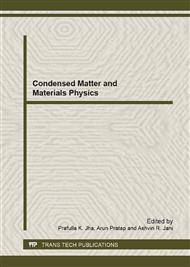[1]
V. A. Guanov, L. Ianovsky, and V. P. Zhukov, Electronic Structure Refractor Carbides and Nitrides, Cambridge University Press, Cambridge, (1994).
Google Scholar
[2]
L. E. Toth, Transition metal carbides and nitrides, Academic Press, New York, (1974).
Google Scholar
[3]
H. O. Pierson, Handbook of Refractory Carbides and Nitrides: Properties, Characteristics and Applications, Noyes, Westwood, NJ. (1996).
Google Scholar
[4]
L. E. Toth, Transition Metal Carbides and Nitrides, Academic New York, (1971).
Google Scholar
[5]
P. Villaes, L. D. Calvet, Pearson's Handbook of Crystallographic Data for Intermetallic Phases, American society for metals, Matal Park, OH., (1985).
Google Scholar
[6]
A. M. Nartowsti, I. P. Parkin, M. Mackenzie, A. Jcraven, I. Macleod, J. Mater. Chem. 9 (1999) 1275-1281.
Google Scholar
[7]
K. Nakamura, M. Yashima, Mater Sci. Eng. B 21, 148 (2005) 69-72.
Google Scholar
[8]
D. A. Papaconstantopoulas, W. E. Pickett, B. M. Klein, L. L. Boyer, Phys. Rev. B 31 (1985) 752- 761.
Google Scholar
[9]
A. Fernandez Guillermet, J. Haglund and G. Grimvall, Phys. Rev. B 45 (1992) 11557-11562.
Google Scholar
[10]
C. Stampfl, W. Mannstadt, R. Asahi, A. J. Freeman, Phys. Rev. B 63 (2001) 155106- 155116.
Google Scholar
[11]
J. C. Crowhurst, A. F. Goncharov, B. Sadigh, J. M. Zaug, D. Aberg, Y. Meng and V. B. Prakapenka, J. Mater. Res. 23 (2008) 1-5.
DOI: 10.1557/jmr.2008.0027
Google Scholar
[12]
R. de. Paiva and R. A. Nogueira, Phys. Rev. B 75 (2007) 085105- 085116.
Google Scholar
[13]
E. Deligoz, K. Colacoglu, Y. O. Ciftci, Phys. Status Solidi B 9 (2010) 247-251.
Google Scholar
[14]
W. Chen., J. Z. Jiang, Journal of Alloys and Compounds, 499 (2010) 243-254.
Google Scholar
[15]
K. K. Koirr, G.O. Amolo and N. W. Makau Diamond and Related Materials 20 (2011) 157-164.
Google Scholar
[16]
P. Blaha, K. Schwarz, G. k. H. Madsen D. Kuasnicka and J. Luitz, K. Schwartz Technical Universitat, Wien, Australia, (2001) ISBN 3-9501031-1-2.
Google Scholar
[17]
J. P. Perdew, K. Burke and M. Ernzerhop, Phys. Rev. Lett. 77 (1996) 3865-1868.
Google Scholar
[18]
F. Birch ,J. Appl. Phys. 9 (1938) 279-288.
Google Scholar


